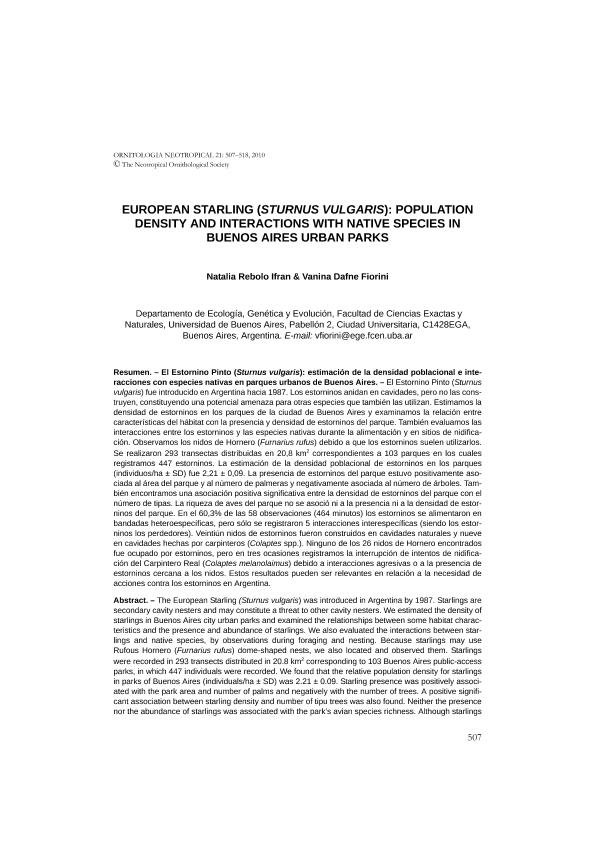Artículo
European starling (Sturnus vulgaris): population density and interactions with native species in Buenos Aires urban parks
Título:
El Estornino Pinto (Sturnus vulgaris): estimación de la densidad poblacional e interacciones con especies nativas en parques urbanos de Buenos Aires
Fecha de publicación:
12/2010
Editorial:
Neotropical Ornithological Society
Revista:
Ornitología Neotropical
ISSN:
1075-4377
Idioma:
Inglés
Tipo de recurso:
Artículo publicado
Clasificación temática:
Resumen
The European Starling (Sturnus vulgaris) was introduced in Argentina by 1987. Starlings are<br />secondary cavity nesters and may constitute a threat to other cavity nesters. We estimated the density of starlings in Buenos Aires city urban parks and examined the relationships between some habitat characteristics and the presence and abundance of starlings. We also evaluated the interactions between starlings and native species, by observations during foraging and nesting. Because starlings may use Rufous Hornero (Furnarius rufus) dome-shaped nests, we also located and observed them. Starlings were recorded in 293 transects distributed in 20.8 km2 corresponding to 103 Buenos Aires public-access parks, in which 447 individuals were recorded. We found that the relative population density for starlings in parks of Buenos Aires (individuals/ha ± SD) was 2.21 ± 0.09. Starling presence was positively associated with the park area and number of palms and negatively with the number of trees. A positive significant association between starling density and number of tipu trees was also found. Neither the presence nor the abundance of starlings was associated with the park’s avian species richness. Although starlings were found to feed in heterospecific flocks in 60.3% of the 58 observations (totally 464 min), only five interspecific interactions were recorded (the starling being always the losing species). Twenty-one starling nests were built in natural cavities and nine in cavities made by woodpeckers (Colaptes spp.). None of the 26 Rufous Hornero nests found was occupied by starlings. However, the nestling cycle of the Golden-breasted Woodpecker (Colaptes melanolaimus) was recorded to be interrupted in three occasions due either to aggressive interactions or to the presence of starlings near the nests. These findings can be relevant in relation with the need of any action against starlings in Argentina.
Archivos asociados
Licencia
Identificadores
Colecciones
Articulos(IEGEBA)
Articulos de INSTITUTO DE ECOLOGIA, GENETICA Y EVOLUCION DE BS. AS
Articulos de INSTITUTO DE ECOLOGIA, GENETICA Y EVOLUCION DE BS. AS
Citación
Rebolo, Natalia; Fiorini, Vanina Dafne; European starling (Sturnus vulgaris): population density and interactions with native species in Buenos Aires urban parks; Neotropical Ornithological Society; Ornitología Neotropical; 21; 4; 12-2010; 507-518
Compartir




